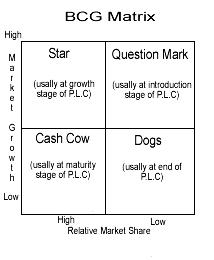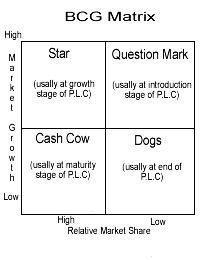BCG GROWTH-SHARE MATRIX
Companies that are large enough to be organized into strategic business units face the challenge ofallocating resources among those business units. In the early 1970, the Boston Consulting Group developeda model for managing a portfolio of different business units (or major product lines). The BCG growthsharematrix displays the various business units on a graph of the market growth rate vs. market sharerelative to competitors:
Resources are allocated to business units according to where they are situated on the grid as follows: 1. Cash Cows - business units that have a large market share in mature, slow growing industries. Cash cows require little investment and generate cash that can be used to invest in other business units. 2. Stars - business units that have a large market share in a fast growing industry. Stars may generate cash, but because the market is growing rapidly, they require investment to maintain their lead. If successful, a star will become a cash cow when its industry matures. 3. Problem Child or Question Mark - business units that have a small market share in a high growth market. These business units require resources to grow market share, but whether they will succeed and become stars is unknown. 4. Dogs - business units that have small market share in a mature industry. A dog may not require substantial cash, but it ties up capital that could better be deployed elsewhere. Unless a dog has some other strategic purpose, it should be liquidated if there is little prospect for it to gain market share. The BCG matrix provides a framework for allocating resources among different business units and allows one to compare many business units at a glance. However, the approach has received some negative criticism for the following reasons: 1. The link between market share and profitability is questionable since increasing market share can be very expensive. 2. The approach may overemphasize high growth, since it ignores the potential of declining markets. 3. The model considers market growth rate to be a given. In practice, the firm may be able to grow the market. The size of the circle indicates the amount of revenue the product/brand/sbu contributes to company
turnover |
|
- Home
-
Applied Analytics
-
Analytics for Decision Making
>
- What is Cluster Analysis
- Data Reduction and Unsupervised Learning
- Preparing Data and Measuring Dissimilarities
- Hierarchical and k-Means Clustering
- Defining Output Variables and Analyzing the Results
- Using Historical Data to Model Uncertainty
- Models with Correlated Uncertain Variables
- Creating and Interpreting Charts
- Using Average Values versus Simulation
- Optimization and Decision Making
- Formulating an Optimization Problem
- Developing a Spreadsheet Model
- Adding Optimization to a Spreadsheet Model
- What-if Analysis and the Sensitivity Report
- Evaluating Scenarios and Visualizing Results to Gain Practical Insights
- Digital Marketing Application of Optimization
- Advanced Models for Better Decisions
- Business Problems with Yes/No Decisions
- Formulation and Solution of Binary Optimization Problems
- Metaheuristic Optimization
- Chance Constraints and Value At Risk
- Simulation Optimization
-
Analytics for Marketing
>
- Marketing Analytics and Customer Satisfaction
- Customer Satisfaction
- Measurements and Scaling Techniques – Introduction
- Primary Scales of Measurement
- Comparative Scaling
- Non-Comparative Scaling
- Experiment Design: Controlling for Experimental Errors
- A/B Testing: Introduction
- A/B Testing: Types of Tests
- ANOVA – Introduction
- Example -Inspect Spray and Tooth Growth
- Logit Model - Binary Outome and Forecastign linear regression
- Text Summarization
- Social media Microscope
- N-Gram - Frequcy Count and phase mining
- LDA Topic Modeling
- Machine-Learned Classification and Semantic Topic Tagging
- Data Engine >
-
Customer Insights
>
- Introduction
- What is Descriptive Analytics?
- Survey Overview
- Net Promoter Score and Self-Reports
- Survey Design
- Passive Data Collection
- Media Planning
- Data Visualization
- Causal Data Collection and Summary
- Asking Predictive Questions
- Regression Analysis
- Data Set Predictions
- Probability Models
- Results and Predictions
- Perspective Analytics (Maximize Revenue and Market Structure Competitions)
-
Analytics for Advance Marketing
>
- Visualisation and statistics (Political Advertising,Movie Theater and Data Assembly)
- Excel Analysis of Motion Picture Industry Data
- Displaying Conditional Distributions
- Analyzing Qualitative Variables
- Steps in Constructing Histograms
- Common Descriptive Statistics for Quantitative Data
- Regression-Based Modeling
- Customer Analytics
- Illustrating Customer Analytics in Excel
- Customer Valuation Excel Demonstration
-
Analytics for Decision Making
>
- Soft Skills
- Marketing
- Finance
-
Economics
- JBDON Golf
- Let's Talk
- MBA Project Sharing
-
About Us
-
Good Read
>
- IIMC says PepsiCo CEO Indra Nooyi was an average student
- India’s middle class figures in Fortune’s Top Ten list of those who matter
- The Start-Up of you.
- BUYING AND MERCHANDISING
- HUMAN RESOURCE MANAGEMENT
- Do You Suffer From Decision Fatigue?
- New Page
- About social media and web 2.0
- Building Your Own Start-up Technology Company, Part 1
- Building Your Own Start-up Technology Company, Part 2
- Building Your Own Start-up Technology Company, Part 3
- Building Your Own Start-up Technology Company, Part 4
- Renewable energy is no longer alternative energy
- What Makes an Exceptional Social Media Manager?
- The Forgotten Book that Helped Shape the Modern Economy
- Home
- How to Think Creatively
- A Lighthearted Looks at Project Management and Sports Analogies
- Why Trust Matters More Than Ever for Brands
-
Good Read
>
- CET Knowledge Zone
- Untitled
- New Page
- Adidas


